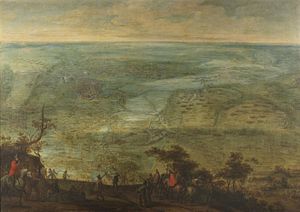Siege of Saint-Omer
| Siege of Saint-Omer | |||||||
|---|---|---|---|---|---|---|---|
| Part of the Thirty Years' War and the Franco-Spanish War (1635-1659) |
|||||||
 The relief of Saint-Omer by Pieter Snayers. Oil on canvas. Museo del Prado, Madrid. |
|||||||
|
|||||||
| Belligerents | |||||||
|
|
|
||||||
| Commanders and leaders | |||||||
|
Thomas Francis, Prince of Carignano, Ottavio Piccolomini |
Gaspard III de Coligny, Jacques-Nompar de Caumont, duc de la Force |
||||||
| Strength | |||||||
| 20,000 infantry and cavalry | 10,000 infantry, 3,000 cavalry (Châtillon) 16,000 infantry and cavalry (La Force) |
||||||
| Casualties and losses | |||||||
| unknown | 4,000 casualties | ||||||
The Siege of Saint-Omer (May 24 – July 16, 1638) was a siege in the Thirty Years' War in which a French army under Gaspard III de Coligny, Maréchal de Châtillon, laid siege to the Flemish city of Saint-Omer, defended by a small garrison in command of Lancelot II Schetz, count of Grobbendonck. Despite several initial successes in the capture of the minor forts around Saint-Omer, on the night of 8/9 June a Spanish relief army under Thomas Francis, Prince of Carignano surprised Châtillon's troops and established a small fort in the middle of the French lines. An entire army corps under Maréchal de La Force was ordered to move towards Saint-Omer to support Châtillon siege, but on July 12 a further Imperial-Spanish force commanded by Ottavio Piccolomini entered Saint-Omer, resolving the French marshals to withdraw.
In June 1635 the allied armies of the Dutch Republic and France invaded the Spanish Netherlands from two sides and joined forces in the valley of the Meuse while the Spanish field army under the Cardinal-Infante fell back to cover Brussels. The invading armies captured a few smaller places before investing Leuven. The siege was a costly failure due to bad logistics and organization, and because the French army was decimated by the plague. The Cardinal-Infante was then able to counter-attack and pushed the Franco-Dutch army back to the Dutch border in the direction of Cleves, recapturing Diest and Tienen, and surprising the Dutch fortress of Schenkenschans, where a large garrison was put then in. The Duchy of Cleves was occupied during August and September with the aim of linking the fort with the main body of the Spanish Netherlands. while Frederick Henry, Prince of Orange, started the siege of Schenkenschans. The fortress fell after a long and costly siege that lasted even through the winter months. Meanwhile, Cardinal Richelieu took the decision of remove Châtillon from command and focused France's effort in the Rhineland.
...
Wikipedia
